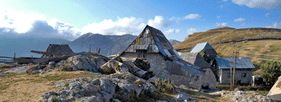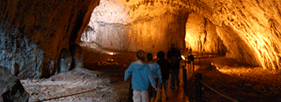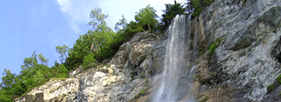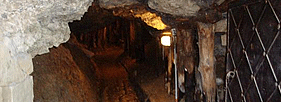Bijambare Cave: natural protected area
The Bijambare area is a complex that consist eight caves near Sarajevo, capital of Bosnia and Herzegovina. Protected Landscape "Bijambare" covers an area of 497 hectares and was established in order to preserve landscapes, scientific research, environmental education and education, and recreation and tourism.
Near the cave is the brook Bradic with a lake and a mill, and the creek Bjelila, which intersects Bijambare forests and glades. Area Bijambara, with Bijambare, is one of the few resorts that fits all nature lovers: a true pleasure for fans of the rock, clear water, pine forest and forest silence. Optimum height above sea level (950 m on average), thick conifer woods, meadows, two water flows with lakes and chasms, five caves, rocky massif and high quality air provide ideal conditions for alpinism, speleology, skiing, mushroom picking, medicinal herb picking, or simply for nature excursions and visits. At an average altitude of 950 m there is a dense evergreen forest with various pine trees and fresh air. There are also beautiful meadows crossed by two creaks that form small lakes and sink underground in the bedrock karstified limestone. In ecological terms, this area is one of the areas with the highest level of vegetation and ecological diversity.
Srednja cave (mid-cave) is the most interesting and most exciting part of this visit. The main cave is of considerable magnitude, 470 m long (along the main path, neglecting branches) with 4 huge "halls” stretching up to 60 m in the diameter and to over 30 m in height. One of the halls (the last one) is commonly called "concert-hall” due to its impressive size. The cave is rich with cave "jewellery” forms such as stalactites, stalagmites, curtains, basins, side-blocks and alike. It is presently inhabited by colony of bats and crickets. It has big speleological structure and the beautiful decoration which make Srednja cave so attractive and it hides in its floor the most important records of the past fauna and mankind prehistory.
Gornja cave (upper-cave) is the oldest cave in Bijambare area. In the past a test hole was excavated and it brought to light information about past ages. Different sediments strata deposits during Pleistocene (from 1.8 Myear to 10000 years ago)were found during this study. Fossils of animals living in cold climes testify about the period of Ice Age (Wurm III), while in upper layers, the presence of remains of animals typical of steppehighlight a shift to a warmer situation. The following Atlantic period (around 8000-45000 yearsago) is considered as the warmer period of the Holocene. Within the animal fossils, one of the most representative inhabitants of the caves during the cold period was the cave bear. This specie was more robust and bigger than the actual bear. Most of the weak and old bears died inside the caves during the hibernation period and for this reason many bones were found. The cave bear became extinct at the end of the last Ice Age around 10000 years ago.
Đuričina cave has an entrance on a wide and steep terrain recess. The first part of the ground covered by trees and grass, while the lower part is still visible collapsed stones, so that the real entrance to the cave at the bottom vrtačastog depressions (former abyss). After a few meters, the cave leads to the NW-SE cracks at which continues the remainder of the cave. This is part of a large hall that stretches along the cracks with a wide opening on the surface of the ceiling of the cave, so the first part of the cave is in fact a natural stone bridge. The most interesting part for further studies is a small corridor that begins in the main hall and runs southwest parallel to the entrance of the cave. This small downward channel is probably associated with Dimšinom cave which is only a few meters (which seems to be confirmed by the air flow in this part of the cave). Due to the morphology of the cave, the snow that fell through a hole in the ceiling accumulates during the winter, and trees and walls to protect from the sun. In addition, the cave is probably accumulates cold air that provides a stable thermal stratification. This all together enables the ice and snow lasts until late spring and early summer, and sometimes throughout the year.























